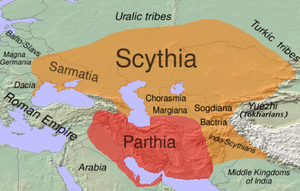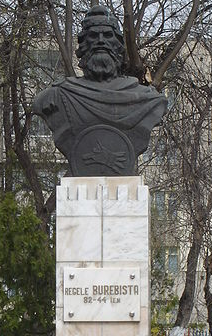Julius Caesar's planned invasion of the Parthian Empire
 From Wikipedia the free encyclopedia
From Wikipedia the free encyclopedia
| Caesar's planned invasion of Parthia | |
|---|---|
| Part of the Roman-Parthian Wars | |
 | |
| Operational scope | Dacia, Middle East and Central Asia |
| Planned | for 44 BC |
| Planned by | Roman Republic under Julius Caesar |
| Target | Burebista's Dacian kingdom, Parthian Empire, various other states and peoples |
| Executed by | Planned:
|
| Outcome | Eventual cancellation and diversion of Roman forces among civil war parties |
Julius Caesar's planned invasion of the Parthian Empire was a planned war of the Roman Republic against the Parthian Empire. The assassination of Julius Caesar in 44 BC prevented the invasion from taking place.[1]
Following his victory in the Civil War against Pompey and his followers in 45 BC, Caesar's authority was uncontested in the Roman Republic. His next plan was to launch an invasion of the Parthian Empire, the other great power of the period, which had, like the Republic, vastly expanded over the previous two centuries. Caesar sought to avenge the disaster of Carrhae in 53 BC, when the Parthians soundly defeated an invading army led by Crassus. The campaign was to start with the pacification of Dacia, followed by an invasion of the Parthian Empire.[1][2][3]
However, the invasion was cancelled with the murder of Julius Caesar on 15 March 44 BC. In 36 BC, Mark Antony, Caesar's former lieutenant, likewise attempted to conquer the Parthian Empire.
Plutarch also claims that once Parthia had been subdued, the army was to continue to Scythia, then Germania and finally back to Rome.[4] Those grander plans are found only in Plutarch's Parallel Lives, and their authenticity is questioned by most scholars.[5]
Preparation and invasion plans
[edit]There is evidence that Caesar had begun practical preparation for the campaign some time before late 45 BC.[6] By 44 BC Caesar had begun a mass mobilization, sixteen legions (c.60,000 men) and 10,000 cavalry were being gathered for the invasion.[7][8] These would be supported by auxiliary cavalry and light armed infantry.[9] In 46 and 45, two supporters of Caesar, Titus Carisius and Lucius Valerius Acisculus, also struck denarii with eastern symbols, such as Sol and the sphinx, which may allude to the planned campaign.[10]
Six of the legions had already been sent to Macedonia to train, along with a large sum of gold for the expedition.[9] Octavius was sent to Apollonia (within modern Albania), ostensibly as a student, to remain in contact with the army.[12] As Caesar planned to be away for some time, he reordered the senate[12] and ensured that all magistrates, consuls and tribunes would be appointed by him during his absence.[13][14] Caesar intended to leave Rome to start the campaign on 18 March; however, three days prior to his departure he was assassinated.[1]

The expedition was planned to take three years.[15] It was to begin with a punitive attack on Dacia under King Burebista, who had been threatening Macedonia's northern border.[15][16] It has been suggested by Christopher Pelling that Dacia, not Parthia, was going to be the expedition's main target.[16]
After Dacia the army was then to invade Parthia from Armenia.[2][3][a][b] The ancient sources diverge. Suetonius states that Caesar wished to proceed cautiously and would not fully engage the Parthian army unless he had determined their full strength.[3] Although he implies that Caesar's goal was an expansion of the empire, not just its stabilization,[5] Plutarch describes a bolder campaign by writing that once Parthia had been subdued, the army would move through the Caucasus, attack Scythia and return to Italy after it had conquered Germania.[4] Plutarch also states that the construction of a canal through the isthmus of Corinth for which Anienus had been placed in charge, was to occur during the campaign.[18][c]
Plutarch's reliability
[edit]Plutarch's Parallel Lives was written with the intention of finding correlations between the lives of famous Romans and Greeks;[20] for example, Caesar was paired with Alexander the Great.[21] Buszard's reading of Parallel Lives also interprets Plutarch as trying to use Caesar's future plans as a case study in the error of unbridled ambition.[21]
Some academics have theorised that Caesar's pairing with Alexander and Trajan's invasion of Parthia, which was around the time of Plutarch's writing, led to exaggerations in the presented invasion plan.[5] The deployment of the army to Macedonia near the Dacian frontier and the lack of military preparation in Syria have also been used to lend support for that hypothesis.[16][22] Malitz acknowledges that the Scythia and Germania plans appear to be unrealistic but believes that they were credible with the geographic knowledge of the time.[15]
Motivation for invasion
[edit]The public excuse for the expedition was that less than ten years earlier, in 53 BC, an invasion of the Parthian Empire had been attempted by Roman Consul Marcus Licinius Crassus[12] and ended in failure and his death at the Battle of Carrhae. To many Romans, that required revenge.[d] Also, Parthia had taken Pompey's side in the recent civil war against Caesar.[23][e]
As the Roman Republic in 45 BC was still politically divided after the civil war, Marcus Cicero tried to lobby Caesar to postpone the Parthian invasion and to solve domestic problems instead. Following a similar line of thought in June that year, Caesar temporarily wavered in his intention to leave with the expedition.[24] However, Caesar finally decided to leave Rome and to join the army in Macedonia.
A number of motivations have been proposed to explain his decision to continue his military career.[25] After a victorious campaign he would have, as Plutarch wrote, "completed this circuit of his empire, which would then be bounded on all sides by the ocean"[26] and returned home with his lifelong dictatorship secured.[6] It has also been proposed that Caesar knew of the threats against him and felt that leaving Rome and being in the company of a loyal army would be safer both personally and politically.[24] Caesar may have also wished to heal the rift from the civil war or to distract from it by reminding the populace of Rome of the threat of a neighbouring empire.[9]
Aftermath
[edit]In order to support a royal title for Caesar, a rumour was spread before the planned invasion. It alleged that it had been prophesied that only a Roman king could defeat Parthia.[7][12] As Caesar's greatest internal opposition came from those that believed he wanted royal power, that strengthened the conspiracy against him.[27]
It has also been proposed that Caesar's opposition would be fearful of him returning victorious from his campaign since he would be more popular than ever.[6][28]
The assassination occurred on 15 March 44 BC on the day that the senate was to debate granting Caesar the title of king for the war with Parthia.[12] However, some of the aspects of Caesar's planned kingship may have been invented after the assassination to justify the act.[5] The relationship between the planned Parthian war and his death, if any, is unknown.[5][29]
After Caesar's death, Mark Antony successfully vied for control of the legions from the planned invasion, which were still stationed in Macedonia, and he temporarily took control of that province to do so.[14] From 40 to 33 BC, Rome and particularly Antony would wage an unsuccessful war against Parthia.[30] He used Caesar's proposed invasion plan, of attacking through Armenia, where it was felt that the support of the local king could be relied on.[9]
In Dacia, Burebista died the same year as Caesar, which led to the dissolution of his kingdom.[12]
Footnotes
[edit]- ^ Caesar's invasion plan used more cavalry than Marcus Licinius Crassus's and approached through the friendly territory of Armenia. It is believed that both factors would have improved his chances of success relative to the earlier attempt.[9]
- ^ From 46 BC Quintus Caecilius Bassus had control of Syria. Bassus had supported Pompey in the civil war, had murdered Caesar's cousin, Sextus Caesar, and defeated the new governor sent by Caesar.[17]
- ^ Nicolaus of Damascus also mentions an intention to continue to India after Parthia.[19]
- ^ According to Dio, the Roman people's desire for that revenge led to Caesar being given sole command of the Parthian campaign by a unanimous vote.[13]
- ^ Parthia was aware of the political divide in Rome and that Caesar's victory in the civil war could lead to invasion.[23]
References
[edit]- ^ a b c Malitz, Caesars Partherkrieg I
- ^ a b Plutarch, Caesar 58.6
- ^ a b c Suetonius, The Life of Julius Caesar 44
- ^ a b Plutarch, Caesar 58.6,7
- ^ a b c d e Townend 1983 p. 601-606
- ^ a b c Malitz, Caesars Partherkrieg V
- ^ a b Appian, The Civil Wars 2.110
- ^ Malitz, Caesars Partherkrieg VI
- ^ a b c d e Poirot, John J. (2014). The Romano-Parthian Cold War: Julio-ClaudianForeign Policy in the First Century CE and Tacitus'Annales. Louisiana State University LSU Digital Commons. pp. 56–58.
- ^ Woods, "Carisius, Acisculus", pp. 253–255.
- ^ Crawford, Roman Republican Coinage, pp. 475, 476, 483–485.
- ^ a b c d e f Heitland 2013 p.469–471.
- ^ a b Cassius Dio, Roman History 43.51
- ^ a b Abbott, Frank Frost (1901). A History and Description of Roman Political Institutions. Adegi Graphics LLC. pp. 137–139. ISBN 9780543927491.
- ^ a b c Malitz, Caesars Partherkrieg VII
- ^ a b c Pelling, Christopher (2011). Plutarch Caesar: Translated with an Introduction and Commentary. OUP Oxford. pp. 438–439. ISBN 9780198149040.
- ^ Strauss, Barry (2016-03-22). The Death of Caesar: The Story of History's Most Famous Assassination. Simon and Schuster. pp. 55, 56, 68. ISBN 9781451668810.
- ^ Plutarch, Caesar 58.8
- ^ Nicolaus of Damascus, Life of Augustus 26
- ^ Stadter, Philip A. "Plutarch's Comparison of Pericles and Fabius Maximus". Greek, Roman, and Byzantine Studies. 16 (1): 77–85.
- ^ a b Buszard, Bradley (2008). "Caesar's Ambition: A Combined Reading of Plutarch's Alexander-Caesar and Pyrrhus-Marius". Transactions of the American Philological Association. 138 (1): 185–215. doi:10.1353/apa.0.0004. ISSN 2575-7199. S2CID 162316551.
- ^ McDermott, W. C. (1982). "Caesar's Projected Dacian-Parthian Expedition". Ancient Society (13): 223–232. ISSN 0066-1619.
- ^ a b Malitz, Caesars Partherkrieg II
- ^ a b Griffin, Miriam (2009). A Companion to Julius Caesar. John Wiley & Sons. pp. 69–70. ISBN 9781444308457.
- ^ Campbell, Brian (2002). Rich, John; Rich, John; Shipley, Graham (eds.). "War and diplomacy: Rome and Parthia, 31 BC–AD 235". War and Society in the Roman World. Chapter 9. doi:10.4324/9780203075548. ISBN 9780203075548.
- ^ Plutarch, Caesar 58.7
- ^ Plutarch, Caesar 60
- ^ Strauss, Barry (2016-03-22). The Death of Caesar: The Story of History's Most Famous Assassination. Simon and Schuster. pp. 56, 68. ISBN 9781451668810.
- ^ Malitz, Caesars Partherkrieg IV
- ^ Bunson, Matthew (2014-05-14). Encyclopedia of the Roman Empire. Infobase Publishing. p. 39. ISBN 9781438110271.
Sources
[edit]Ancient
[edit]- Appian, The Civil Wars
- Cassius Dio, Roman History
- Nicolaus of Damascus, Life of Augustus
- Plutarch, Parallel Lives.
- Suetonius, The Twelve Caesars.
Modern
[edit]- Crawford, Michael (1974). Roman Republican Coinage. Cambridge University Press.
- Heitland, W. E. (2013). A Short History of the Roman Republic. Cambridge University Press. pp. 469–471. ISBN 9781107621039.
- Malitz, Jürgen (1984). "Caesars Partherkrieg (English title: Caesar's Parthian War)" (PDF). Historia: Zeitschrift für Alte Geschichte. Bd. 33, H. 1: 21–59.
- Townend, G. B. (1983). "A Clue to Caesar's unfulfilled Intentions". Latomus. 42 (3): 601–606. JSTOR 41532893.
- Woods, David (2013). "Carisius, Acisculus, and the Riddle of the Sphinx". American Journal of Numismatics (1989-). 25: 243–257. JSTOR 43580630.
External links
[edit]- History of Rome podcast: by Mike Duncan contextualizing and describing invasion plans.

